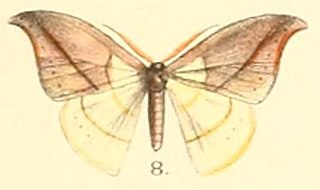Tridrepana lunulata is a moth in the family Drepanidae. It was described by Arthur Gardiner Butler in 1887. It is found in Indonesia, Papua New Guinea and Australia, where it has been recorded from northern Queensland.
Tridrepana maculosa is a moth in the family Drepanidae. It was described by Watson in 1957. It is found in the Chinese provinces of Sichuan and Yunnan.

Tridrepana postica is a moth in the family Drepanidae. It was described by Frederic Moore in 1879. It is found in north-eastern India and Malaysia.
Tridrepana subtusmaculata is a moth in the family Drepanidae. It was described by Max Gaede in 1933. It is found on Peninsular Malaysia and Borneo.
Tridrepana adelpha is a moth in the family Drepanidae. It was described by Swinhoe in 1905. It is found in north-eastern India.
Tridrepana sigma is a moth in the family Drepanidae. It was described by Allan Watson in 1957. It is found in Indonesia.
Tridrepana acuta is a moth in the family Drepanidae. It was described by Allan Watson in 1957. It is found in Sri Lanka and possibly southern India.
Tridrepana trialba is a moth in the family Drepanidae. It was described by Allan Watson in 1957. It is found on Sulawesi in Indonesia.
Tridrepana spatulata is a moth in the family Drepanidae. It was described by Allan Watson in 1957. It is found on Luzon and Mindanao in the Philippines.
Tridrepana aequinota is a moth in the family Drepanidae. It was described by Allan Watson in 1957. It is found on Buru in Indonesia.
Tridrepana mediata is a moth in the family Drepanidae. It was described by Warren in 1922. It is found in New Guinea, extending to Goodenough Island and Sudest Island in the south-west.
Tridrepana obscura is a moth in the family Drepanidae. It was described by Allan Watson in 1957. It is found in Indonesia.
Tridrepana sera is a moth in the family Drepanidae. It was first described by William Warren in 1896. It is found on Fergusson Island and in New Guinea.
Tridrepana septempunctata is a moth in the family Drepanidae. It was described by Warren in 1896. It is found in Assam in India and on Sumatra in Indonesia.
Tridrepana examplata is a moth in the family Drepanidae. It was described by Warren in 1922. It is widely distributed in New Guinea, where it is especially common in mountainous areas.
Tridrepana olivacea is a moth in the family Drepanidae. It was described by Warren in 1922. It is found in New Guinea, extending to Goodenough Island and the Bismarck Archipelago.
Tridrepana cervina is a moth in the family Drepanidae. It was described by Warren in 1922. It is found in New Guinea.
Tridrepana obliquitaenia is a moth in the family Drepanidae. It was described by Warren in 1922. It is widely distributed in New Guinea.
Tridrepana rectifascia is a moth in the family Drepanidae. It was described by Allan Watson in 1957. It is found on Mindanao in the Philippines.
Tridrepana aurorina is a moth in the family Drepanidae. It was described by Felix Bryk in 1943. It is found in north-eastern Myanmar.
